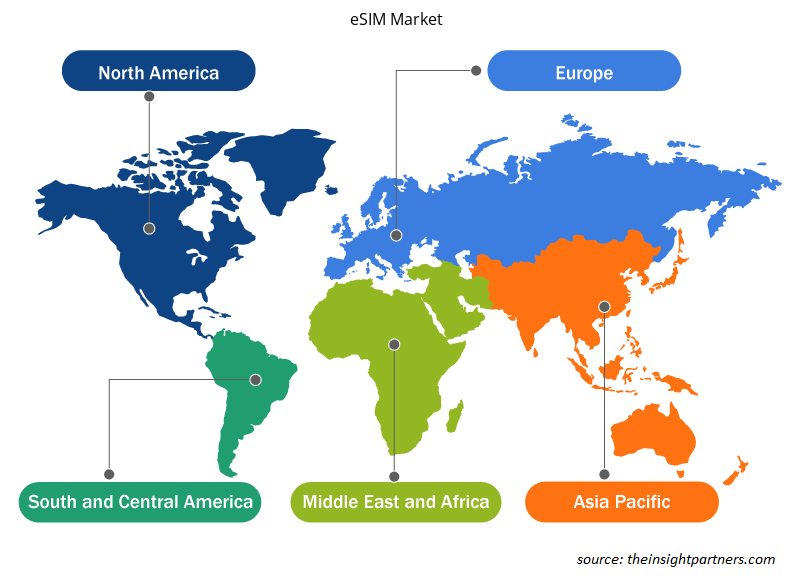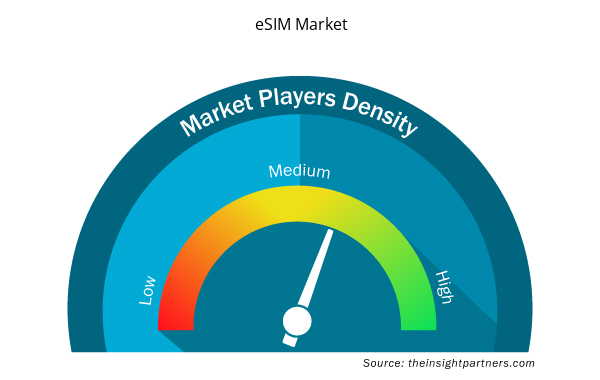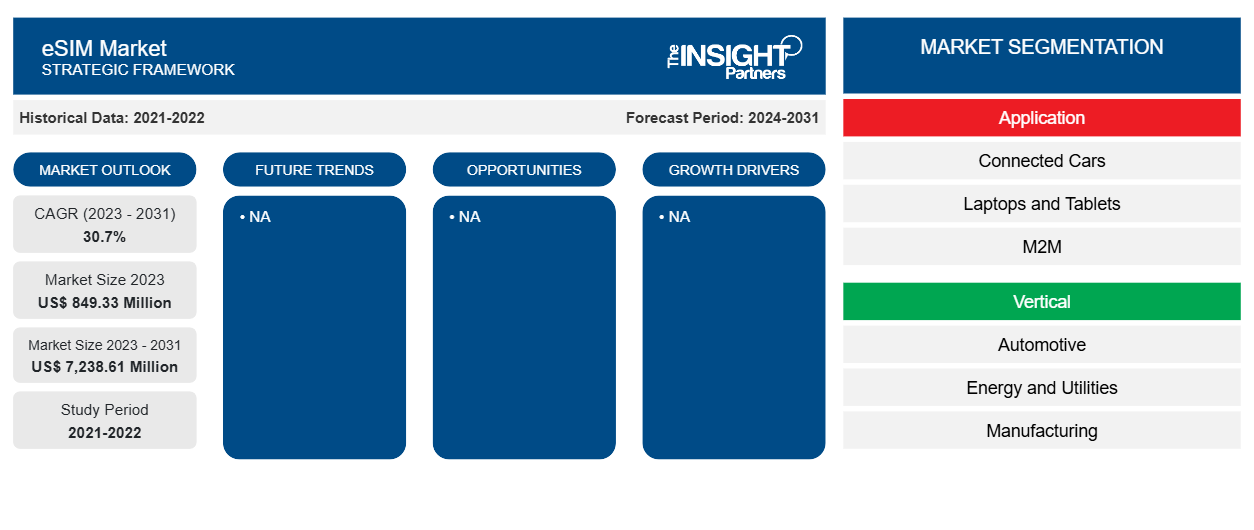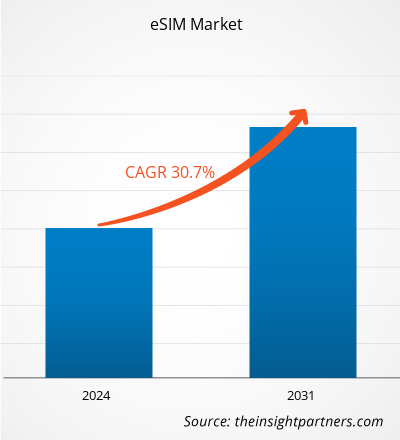Der eSIM-Markt soll von 849,33 Millionen US-Dollar im Jahr 2023 auf 7.238,61 Millionen US-Dollar im Jahr 2031 anwachsen. Der Markt soll zwischen 2023 und 2031 eine durchschnittliche jährliche Wachstumsrate (CAGR) von 30,7 % verzeichnen. Die zunehmende Akzeptanz der IoT-Technologie bei den Kunden dürfte ein wichtiger Trend auf dem eSIM-Markt bleiben.
eSIM-Marktanalyse
Der eSIM-Markt wächst rasant, da der Fokus zunehmend auf der Remote-SIM-Bereitstellung für M2M liegt und die Nachfrage der Verbraucher nach innovativen Unterhaltungselektronikgeräten steigt. Der Markt wächst stetig, angetrieben durch günstige staatliche Vorschriften für die M2M-Kommunikation. Darüber hinaus bietet die steigende Nachfrage nach intelligenten Lösungen lukrative Möglichkeiten für Marktwachstum.
eSIM-Marktübersicht
Die eSIM (Embedded Subscriber Identity Module) ist eine digitale SIM-Karte, die sich mühelos in ein Mobilgerät wie ein Tablet oder Smartphone integrieren lässt. Im Gegensatz zu herkömmlichen physischen SIM-Karten, die entfernt und ersetzt werden können, wird eine eSIM nahtlos in die Hardware-Infrastruktur des Geräts integriert und kann sorgfältig mit einer Vielzahl von Mobilfunkprofilen programmiert werden. Diese Funktion ermöglicht es Verbrauchern, problemlos zwischen Anbietern zu wechseln und ihre Mobilfunktarife einfach zu starten oder anzupassen, ohne dass eine physische SIM-Karte ausgetauscht werden muss.
Die Einführung der eSIM in der Automobilindustrie ermöglicht eine größere Flexibilität bei der Ausstattung von LKWs und PKWs mit Mobilfunkkonnektivität durch die Implementierung zusätzlicher Funktionen. Der Automobilsektor plant, die nächste Generation vernetzter Automobile einzuführen, indem er die GSMA Embedded SIM Specification für eine verbesserte Fahrzeugkonnektivität unterstützt. Dies soll die Sicherheit für eine Vielzahl verknüpfter Dienste verbessern. Die eSIM birgt jedoch ein enormes Potenzial in der Automobilindustrie und dürfte im Prognosezeitraum Wachstumschancen schaffen.
Passen Sie diesen Bericht Ihren Anforderungen an
Sie erhalten kostenlos individuelle Anpassungen an jedem Bericht, einschließlich Teilen dieses Berichts oder einer Analyse auf Länderebene, eines Excel-Datenpakets sowie tolle Angebote und Rabatte für Start-ups und Universitäten.
- Holen Sie sich die wichtigsten Markttrends aus diesem Bericht.Dieses KOSTENLOSE Beispiel umfasst eine Datenanalyse von Markttrends bis hin zu Schätzungen und Prognosen.
Treiber und Chancen für den eSIM-Markt
Wachsender Fokus auf Remote-SIM-Bereitstellung für M2M begünstigt den Markt
Mithilfe der Remote-Bereitstellung können Benutzer ein Betreiberprofil auf eine SIM-Karte im Markt herunterladen und SIM-Profile (Subscriber Identity Module) ändern oder löschen, ohne physisch auf die SIM-Karte zugreifen zu müssen. Die eSIM-Karte ist eine wesentliche Komponente für Machine-to-Machine-Verbindungen (M2M), die einfache und nahtlose mobile Verbindungen für alle Arten von verbundenen Geräten umfassen. M2M erfordert eine umfassende Konnektivität über geografische Regionen hinweg. eSIM macht den Unannehmlichkeiten eines Wechsels des Dienstanbieters ein Ende, steigert die Betriebseffizienz und funktioniert in einer kontrollierten und sicheren Umgebung. Die neuesten eSIM-Karten gewährleisten Profilkompatibilität und bieten eine wichtige Plattform für Gamer, um auf gemeinsamer Basis zusammenzuarbeiten.eSIM card is an essential component for machine-to-machine (M2M) connections, which include simple and seamless mobile connections for all forms of linked devices. M2M requires pervasive connectivity across geographic regions. eSIM eliminates the inconvenience of changing service providers, increasing operational efficiency, and functions in a controlled and secure environment. The most recent eSIM cards ensure profile compatibility and provide a major platform for gamers to collaborate on common grounds.
Steigende Nachfrage nach intelligenten Lösungen – eine Chance in eSIMeSIM
Verschiedene intelligente Lösungen wie Elektrofahrzeuge, Smart Cities und Smart Meter werden weltweit zunehmend eingesetzt, da die IoT-Infrastruktur Flexibilität und Konnektivität bietet und das Wachstum von Smart Cities und Infrastrukturen in Schwellenländern beschleunigt. Die Entwicklung und Erweiterung von Netzwerken, die geringeren Kosten für Hardwarekomponenten, einschließlich Aktuatoren und Sensoren, und die Entstehung neuer Geschäftsmodelle sind einige Schlüsselfaktoren, die Dienste wie die Bereitstellung von Smart Grids, automatische Sicherheitssysteme, vernetzte Autos und viele andere einführen. Dies führt zu erhöhten Investitionen in die Entwicklung innovativer intelligenter Lösungen für Kunden. Der erhöhte Bedarf an intelligenten Lösungen in zahlreichen Branchen wie Automobil, Energie und Versorgung, Fertigung, Einzelhandel, Unterhaltungselektronik, Transport und Logistik und anderen schafft im Prognosezeitraum Chancen für eSIM-Marktteilnehmer.
Segmentierungsanalyse des eSIM-Marktberichts
Wichtige Segmente, die zur Ableitung der eSIM-Marktanalyse beigetragen haben, sind Anwendung und Vertikale.
- Basierend auf der Anwendung ist der eSIM-Markt in vernetzte Autos, Laptops und Tablets, M2M, Smartphones, Wearables und andere unterteilt. Das M2M-Segment hatte im Jahr 2023 einen größeren Marktanteil.
- Auf vertikaler Basis ist der Markt in die Bereiche Automobil, Energie und Versorgung, Fertigung, Einzelhandel, Unterhaltungselektronik, Transport und Logistik und andere segmentiert. Das Segment Unterhaltungselektronik hielt im Jahr 2023 den größten Marktanteil.
eSIM-Marktanteilsanalyse nach Geografie
Der geografische Umfang des eSIM-Marktberichts ist hauptsächlich in fünf Regionen unterteilt: Nordamerika, Asien-Pazifik, Europa, Naher Osten und Afrika sowie Südamerika/Süd- und Mittelamerika. In Bezug auf den Umsatz hatte Nordamerika aufgrund des technologischen Fortschritts den größten eSIM-Marktanteil.
Der asiatisch-pazifische Raum wird im Prognosezeitraum voraussichtlich mit einer signifikanten durchschnittlichen jährlichen Wachstumsrate wachsen. Der Markt in dieser Region ist in Australien, China, Japan, Indien, Südkorea und den Rest des asiatisch-pazifischen Raums segmentiert. Die Präsenz wichtiger Smartphone-Player wie Huawei Technologies Co Ltd und Samsung Electronics Co Ltd hat eSIM-Handsets entwickelt, die die Einführung von eSIM auf dem Smartphone-Markt beschleunigen. Darüber hinaus wird eSIM auch als die Zukunft der SIM-Technologie für vernetzte Geräte dargestellt. Darüber hinaus entwickeln verschiedene OEMs aus Ländern wie China und Indien eSIM-Lösungen und bilden kollaborative Entwicklungsteams im gesamten Ökosystem, um taktische Entwicklungspfade zu schaffen. So hat beispielsweise IDEMIA, ein eSIM-Hersteller, im Juni 2021 eine neue Produktionsstätte in Indien eröffnet, die die weltweite eSIM-Produktionskapazität erweitern soll. Laut dem deutschen Digitallösungsunternehmen Giesecke+Devrient (G&D) werden bis Ende 2024 25 bis 30 % aller Smartphones über eine eSIM-Funktionalität verfügen. Die mit der zunehmenden Digitalisierung einhergehende Expansion der Smartphone-Branche schafft im Prognosezeitraum jedoch Chancen für den Markt.
Regionale Einblicke in den eSIM-Markt
Die regionalen Trends und Faktoren, die den eSIM-Markt im Prognosezeitraum beeinflussen, wurden von den Analysten von Insight Partners ausführlich erläutert. In diesem Abschnitt werden auch eSIM-Marktsegmente und -Geografie in Nordamerika, Europa, im asiatisch-pazifischen Raum, im Nahen Osten und Afrika sowie in Süd- und Mittelamerika erörtert.

- Holen Sie sich die regionsspezifischen Daten für den eSIM-Markt
Umfang des eSIM-Marktberichts
| Berichtsattribut | Details |
|---|---|
| Marktgröße im Jahr 2023 | 849,33 Millionen US-Dollar |
| Marktgröße bis 2031 | 7.238,61 Millionen US-Dollar |
| Globale CAGR (2023 - 2031) | 30,7 % |
| Historische Daten | 2021-2022 |
| Prognosezeitraum | 2024–2031 |
| Abgedeckte Segmente | Nach Anwendung
|
| Abgedeckte Regionen und Länder | Nordamerika
|
| Marktführer und wichtige Unternehmensprofile |
|
Dichte der eSIM-Marktakteure: Die Auswirkungen auf die Geschäftsdynamik verstehen
Der eSIM-Markt wächst rasant, angetrieben durch die steigende Nachfrage der Endnutzer aufgrund von Faktoren wie sich entwickelnden Verbraucherpräferenzen, technologischen Fortschritten und einem größeren Bewusstsein für die Vorteile des Produkts. Mit steigender Nachfrage erweitern Unternehmen ihr Angebot, entwickeln Innovationen, um die Bedürfnisse der Verbraucher zu erfüllen, und nutzen neue Trends, was das Marktwachstum weiter ankurbelt.
Die Marktteilnehmerdichte bezieht sich auf die Verteilung der Firmen oder Unternehmen, die in einem bestimmten Markt oder einer bestimmten Branche tätig sind. Sie gibt an, wie viele Wettbewerber (Marktteilnehmer) in einem bestimmten Marktraum im Verhältnis zu seiner Größe oder seinem gesamten Marktwert präsent sind.
Die wichtigsten auf dem eSIM-Markt tätigen Unternehmen sind:
- DEUTSCHE TELEKOM AG
- Gemalto NV
- GieseckeDevrient GmbH
- IDEMIA
- INFINEON TECHNOLOGIES AG
- NXP SEMICONDUCTORS NV
Haftungsausschluss : Die oben aufgeführten Unternehmen sind nicht in einer bestimmten Reihenfolge aufgeführt.

- Überblick über die wichtigsten Akteure auf dem eSIM-Markt
Neuigkeiten und aktuelle Entwicklungen zum eSIM-Markt
Der eSIM-Markt wird durch die Erhebung qualitativer und quantitativer Daten nach Primär- und Sekundärforschung bewertet, die wichtige Unternehmensveröffentlichungen, Verbandsdaten und Datenbanken umfasst. Im Folgenden finden Sie eine Liste der Entwicklungen auf dem eSIM-Markt und der Strategien:
- Im Februar 2023 hat Amdocs Ltd in Zusammenarbeit mit Drei Austria eine innovative eSIM-Lösung auf den Markt gebracht, die es den Kunden des österreichischen Betreibers ermöglicht, die Vorteile der digitalen eSIM-Technologie in einem rein appbasierten Erlebnis zu nutzen. Kunden von Drei Austria, die die up³-App verwenden, können ihre eSIM jetzt auf Geräten von Apple, Google, Samsung und anderen Herstellern verwalten. (Quelle: Amdocs Ltd, Pressemitteilung, 2023)
- Im Dezember 2022 kündigte Grover die Einführung seines eigenen virtuellen Mobilfunkanbieters (MVNO) für Kunden aus dem Technikverleih, Grover Connect, in den USA an. Mit Grover Connect können US-Kunden jedes eSIM-fähige Technikgerät problemlos und ohne Aufwand aktivieren. Die Grover eSIM steht Kunden in den USA beim Checkout zur Verfügung und wird in naher Zukunft auch auf den europäischen Märkten eingeführt. (Quelle: Grover, Pressemitteilung, 2022)
- Im Oktober 2022 brachte Bharti Airtel Ltd die „Always On“-IoT-Konnektivitätslösung in Indien auf den Markt. Die „Always On“-Lösung von Airtel umfasst eine Dual-Profile-M2M-eSim, die es einem IOT-Gerät ermöglicht, immer mit einem Mobilfunknetz verschiedener Mobilfunknetzbetreiber (MNOs) in der eSIM verbunden zu bleiben. Die Lösung von Airtel ist eine AIS-140-kompatible Dual-Profile-M2M-eSim, die sich am besten für Fahrzeugortungsanbieter, Autohersteller und alle Anwendungsfälle eignet, in denen Geräte an abgelegenen Standorten arbeiten, die allgegenwärtige Konnektivität erfordern. (Quelle: Bharti Airtel Ltd, Pressemitteilung, 2022)
Abdeckung und Ergebnisse des eSIM-Marktberichts
Der Bericht „eSIM-Marktgröße und -Prognose (2021–2031)“ bietet eine detaillierte Analyse des Marktes, die die folgenden Bereiche abdeckt:
- Marktgröße und Prognose auf globaler, regionaler und Länderebene für alle wichtigen Marktsegmente, die im Rahmen des Projekts abgedeckt sind
- Marktdynamik wie Treiber, Beschränkungen und wichtige Chancen
- Wichtige Zukunftstrends
- Detaillierte PEST/Porters Five Forces- und SWOT-Analyse
- Globale und regionale Marktanalyse mit wichtigen Markttrends, wichtigen Akteuren, Vorschriften und aktuellen Marktentwicklungen
- Branchenlandschaft und Wettbewerbsanalyse, einschließlich Marktkonzentration, Heatmap-Analyse, prominenten Akteuren und aktuellen Entwicklungen
- Detaillierte Firmenprofile
- Historische Analyse (2 Jahre), Basisjahr, Prognose (7 Jahre) mit CAGR
- PEST- und SWOT-Analyse
- Marktgröße Wert/Volumen – Global, Regional, Land
- Branche und Wettbewerbsumfeld
- Excel-Datensatz



Report Coverage
Revenue forecast, Company Analysis, Industry landscape, Growth factors, and Trends

Segment Covered
This text is related
to segments covered.

Regional Scope
North America, Europe, Asia Pacific, Middle East & Africa, South & Central America

Country Scope
This text is related
to country scope.
Häufig gestellte Fragen
The global eSIM market was estimated to be US$ 849.33 million in 2023 and is expected to grow at a CAGR of 30.7% during the forecast period 2023 - 2031.
The growing focus on remote SIM provisioning for M2M and rising demand for innovative consumer electronics devices among consumers are the major factors that propel the global eSIM market.
The rising adoption of IoT technology among customers is anticipated to play a significant role in the global eSIM market in the coming years.
The key players holding majority shares in the global eSIM market are Deutsche Telekom AG, Thales SA, IDEMIA France SAS, Infineon Technologies AG, and NXP Semiconductors NV.
The global eSIM market is expected to reach US$ 7,238.61 million by 2031.
The incremental growth expected to be recorded for the global eSIM market during the forecast period is US$ 6,389.28 million.
Trends and growth analysis reports related to Electronics and Semiconductor : READ MORE..
The Insight Partners performs research in 4 major stages: Data Collection & Secondary Research, Primary Research, Data Analysis and Data Triangulation & Final Review.
- Data Collection and Secondary Research:
As a market research and consulting firm operating from a decade, we have published and advised several client across the globe. First step for any study will start with an assessment of currently available data and insights from existing reports. Further, historical and current market information is collected from Investor Presentations, Annual Reports, SEC Filings, etc., and other information related to company’s performance and market positioning are gathered from Paid Databases (Factiva, Hoovers, and Reuters) and various other publications available in public domain.
Several associations trade associates, technical forums, institutes, societies and organization are accessed to gain technical as well as market related insights through their publications such as research papers, blogs and press releases related to the studies are referred to get cues about the market. Further, white papers, journals, magazines, and other news articles published in last 3 years are scrutinized and analyzed to understand the current market trends.
- Primary Research:
The primarily interview analysis comprise of data obtained from industry participants interview and answers to survey questions gathered by in-house primary team.
For primary research, interviews are conducted with industry experts/CEOs/Marketing Managers/VPs/Subject Matter Experts from both demand and supply side to get a 360-degree view of the market. The primary team conducts several interviews based on the complexity of the markets to understand the various market trends and dynamics which makes research more credible and precise.
A typical research interview fulfils the following functions:
- Provides first-hand information on the market size, market trends, growth trends, competitive landscape, and outlook
- Validates and strengthens in-house secondary research findings
- Develops the analysis team’s expertise and market understanding
Primary research involves email interactions and telephone interviews for each market, category, segment, and sub-segment across geographies. The participants who typically take part in such a process include, but are not limited to:
- Industry participants: VPs, business development managers, market intelligence managers and national sales managers
- Outside experts: Valuation experts, research analysts and key opinion leaders specializing in the electronics and semiconductor industry.
Below is the breakup of our primary respondents by company, designation, and region:

Once we receive the confirmation from primary research sources or primary respondents, we finalize the base year market estimation and forecast the data as per the macroeconomic and microeconomic factors assessed during data collection.
- Data Analysis:
Once data is validated through both secondary as well as primary respondents, we finalize the market estimations by hypothesis formulation and factor analysis at regional and country level.
- Macro-Economic Factor Analysis:
We analyse macroeconomic indicators such the gross domestic product (GDP), increase in the demand for goods and services across industries, technological advancement, regional economic growth, governmental policies, the influence of COVID-19, PEST analysis, and other aspects. This analysis aids in setting benchmarks for various nations/regions and approximating market splits. Additionally, the general trend of the aforementioned components aid in determining the market's development possibilities.
- Country Level Data:
Various factors that are especially aligned to the country are taken into account to determine the market size for a certain area and country, including the presence of vendors, such as headquarters and offices, the country's GDP, demand patterns, and industry growth. To comprehend the market dynamics for the nation, a number of growth variables, inhibitors, application areas, and current market trends are researched. The aforementioned elements aid in determining the country's overall market's growth potential.
- Company Profile:
The “Table of Contents” is formulated by listing and analyzing more than 25 - 30 companies operating in the market ecosystem across geographies. However, we profile only 10 companies as a standard practice in our syndicate reports. These 10 companies comprise leading, emerging, and regional players. Nonetheless, our analysis is not restricted to the 10 listed companies, we also analyze other companies present in the market to develop a holistic view and understand the prevailing trends. The “Company Profiles” section in the report covers key facts, business description, products & services, financial information, SWOT analysis, and key developments. The financial information presented is extracted from the annual reports and official documents of the publicly listed companies. Upon collecting the information for the sections of respective companies, we verify them via various primary sources and then compile the data in respective company profiles. The company level information helps us in deriving the base number as well as in forecasting the market size.
- Developing Base Number:
Aggregation of sales statistics (2020-2022) and macro-economic factor, and other secondary and primary research insights are utilized to arrive at base number and related market shares for 2022. The data gaps are identified in this step and relevant market data is analyzed, collected from paid primary interviews or databases. On finalizing the base year market size, forecasts are developed on the basis of macro-economic, industry and market growth factors and company level analysis.
- Data Triangulation and Final Review:
The market findings and base year market size calculations are validated from supply as well as demand side. Demand side validations are based on macro-economic factor analysis and benchmarks for respective regions and countries. In case of supply side validations, revenues of major companies are estimated (in case not available) based on industry benchmark, approximate number of employees, product portfolio, and primary interviews revenues are gathered. Further revenue from target product/service segment is assessed to avoid overshooting of market statistics. In case of heavy deviations between supply and demand side values, all thes steps are repeated to achieve synchronization.
We follow an iterative model, wherein we share our research findings with Subject Matter Experts (SME’s) and Key Opinion Leaders (KOLs) until consensus view of the market is not formulated – this model negates any drastic deviation in the opinions of experts. Only validated and universally acceptable research findings are quoted in our reports.
We have important check points that we use to validate our research findings – which we call – data triangulation, where we validate the information, we generate from secondary sources with primary interviews and then we re-validate with our internal data bases and Subject matter experts. This comprehensive model enables us to deliver high quality, reliable data in shortest possible time.


 Holen Sie sich ein kostenloses Muster für diesen Bericht
Holen Sie sich ein kostenloses Muster für diesen Bericht